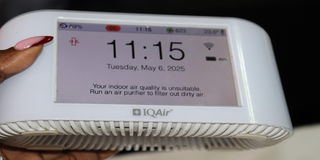Areas around Gioto, PGH and NAWASSCO have high air pollution levels, data reveals

A sample of the sensors installed across Nakuru city that collect air quality data.
Nakuru city people, your air is mid.
It’s not shade, it’s science.
Researchers have spent the last three years quietly tracking air quality in the city through the RESPIRA project, and the results have been mixed.
Eight high-tech sensors installed at places like Nyayo Gardens, Nakuru Athletics Club, Kingdom Seekers Church, and the Nakuru Teaching and Referral Hospital have been collecting data on what we’re inhaling.
The sensor locations were selected based on socioeconomic and demographic factors such as population density, foot traffic, and levels of economic activity, according to Mr. Ngongang Danube, a Technical Air Quality Expert from the Stockholm Environment Institute (SEI),
“Over the past three years, we’ve collected air quality data across different land-use areas in Nakuru. The findings show how pollution levels fluctuate depending on nearby activities, and the drivers of air pollution differ from one location to another,” says Danube.
These findings are also shaping new warning systems that could let you know when to wear a mask, stay indoors, or other protective measures you could take.
Danube points out that using the incinerator at the Nakuru Teaching and Referral Hospital contributes to higher levels of PM2.5 (fine particles small enough to enter the lungs and bloodstream, posing serious health risks).
On the other hand, the Nakuru Athletics Club, which is surrounded by a natural green belt of trees, consistently shows better air quality.
“Trees act as natural filters, helping to keep PM2.5 levels below the WHO average limits,” he says.
Additionally, he expresses concern about the pollution levels near NAWASSCO, where evening spikes have been observed, which is often linked to street vendors using firewood for their economic activities. Same applies to Gioto dumpsite.
To harness both technology and local knowledge, the project is now pairing artificial intelligence and community participation with eleven members of the Ward Climate Change Planning Committee (WCCPC) trained to report pollution events in real time.
“Together, these data sources will not only support the development of an early warning system that can forecast pollution levels 48 to 72 hours in advance but also influence behavioral change. These warnings will be especially useful for people with chronic respiratory illnesses like asthma and COPD, helping them take simple protective steps such as wearing masks or keeping windows closed,” says Dr. Nick Rahier, a research anthropologist from KU Leuven University and one of the project’s principal investigators.
This information will also support public agencies like the Kenya Meteorological Department, which is responsible for producing yearly air quality reports but often lacks sufficient reliable data.
The trained ambassadors are expected to select 30 residents each, with equal representation of men and women, to form a diverse panel of community reporters which will create a network of 330 AngaWatchers over the next year and a half, all trained to report incidents of air pollution and share community experiences.
Nakuru, like many fast-growing urban centers in Kenya, has seen a rise in air pollution linked to increasing traffic, industrial activity, and shifting weather patterns.
According to 2019 data from the county’s Department of Environment, the county produced more than 1.64 million tons of greenhouse gas emissions, which originated mostly from energy, transport, and waste. That translates to around 0.8 tons per person.
Grace Karanja, Nakuru County’s Director of Environment, Climate Change, and Energy, says these are just the first steps the county is taking to monitor air quality more systematically.
“This is just the beginning, and we hope to continue innovating. Currently, among our climate action interventions, we have installed new combustion gadgets in the department’s vehicles that burn fumes and convert them into fuel instead of emitting smoke. We are also aiming to scale this technology to other sectors, including transportation and other government departments,” she notes.
